Factors Influencing Perception in Organizational Behavior: An Analysis
VerifiedAdded on 2020/03/04
|12
|2892
|89
Essay
AI Summary
This essay delves into the significance of perception within organizational behavior, examining how individuals organize and interpret sensory information to make decisions. It highlights factors that distort perception, including individual characteristics, situational influences, and target attributes. The essay explores the impact of these distortions on decision-making and organizational outcomes, emphasizing the need for managers to understand and mitigate biases. Furthermore, it provides strategies to overcome perception problems, such as recognizing personal biases, providing adequate training, and fostering a work environment that values diverse perspectives and creative thinking. The essay underscores the importance of accurate perception for effective leadership, teamwork, and ethical decision-making within organizations, offering practical insights for improving these critical aspects of organizational behavior.
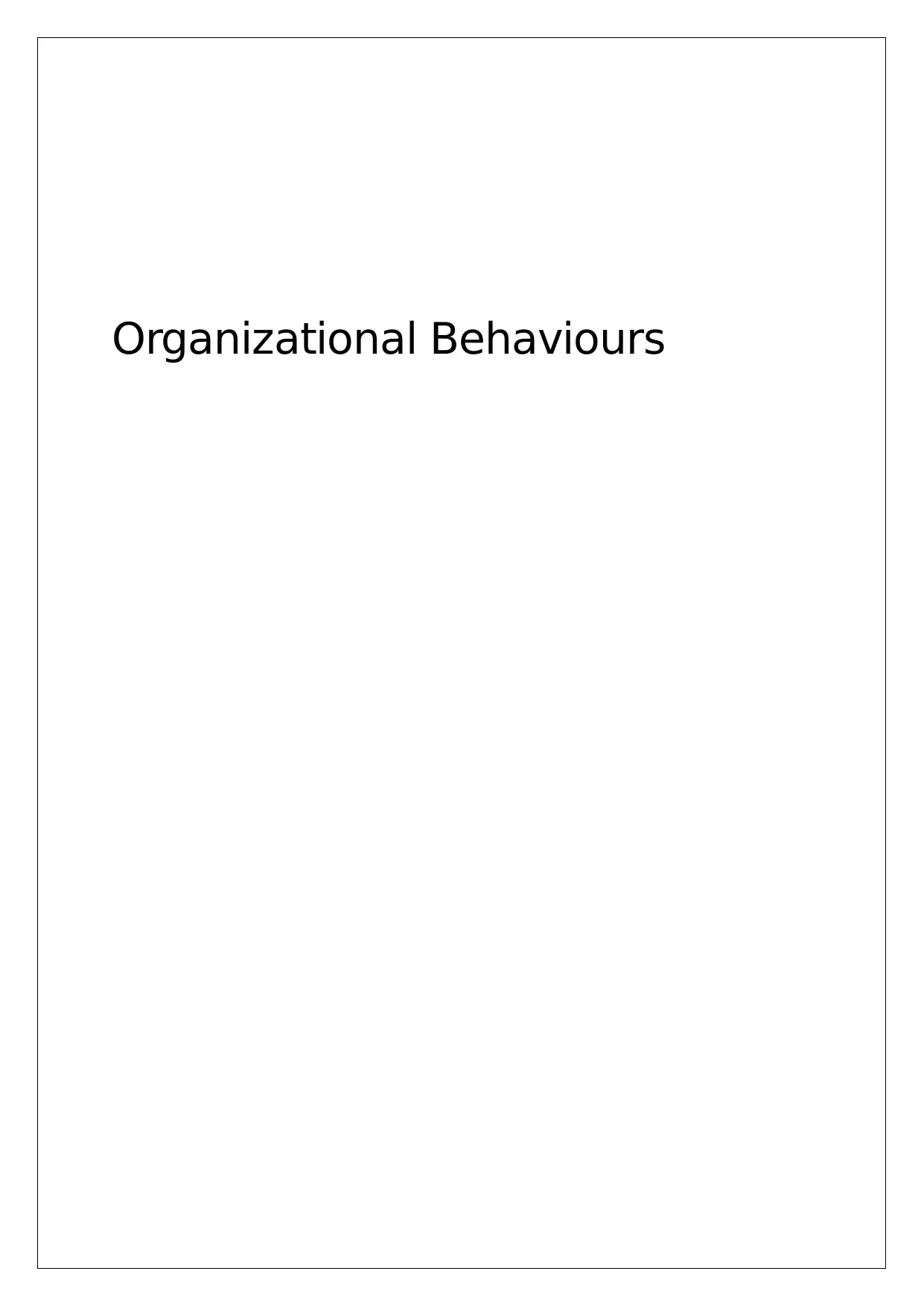
Organizational Behaviours
Paraphrase This Document
Need a fresh take? Get an instant paraphrase of this document with our AI Paraphraser
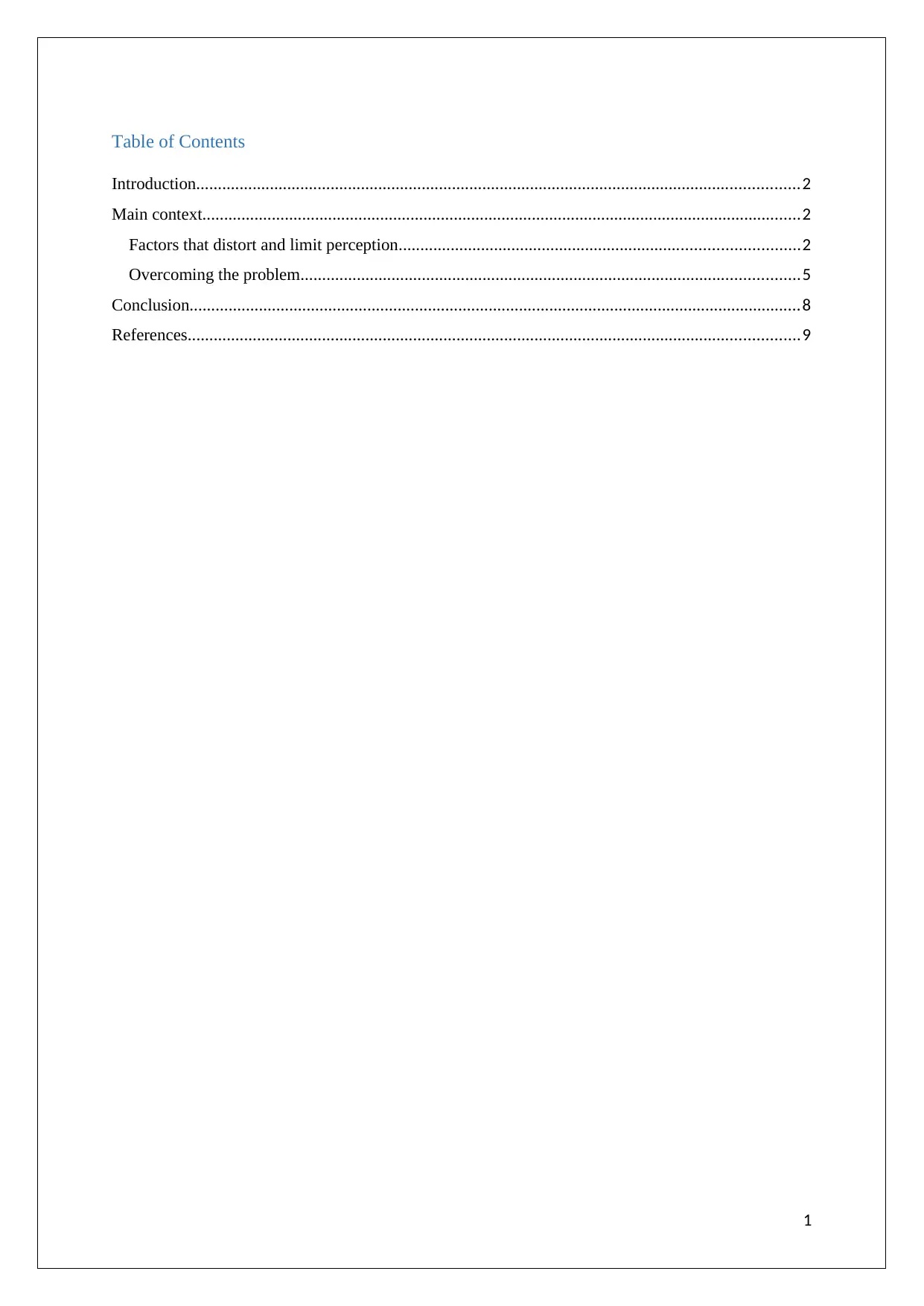
Table of Contents
Introduction...........................................................................................................................................2
Main context..........................................................................................................................................2
Factors that distort and limit perception............................................................................................2
Overcoming the problem...................................................................................................................5
Conclusion.............................................................................................................................................8
References.............................................................................................................................................9
1
Introduction...........................................................................................................................................2
Main context..........................................................................................................................................2
Factors that distort and limit perception............................................................................................2
Overcoming the problem...................................................................................................................5
Conclusion.............................................................................................................................................8
References.............................................................................................................................................9
1
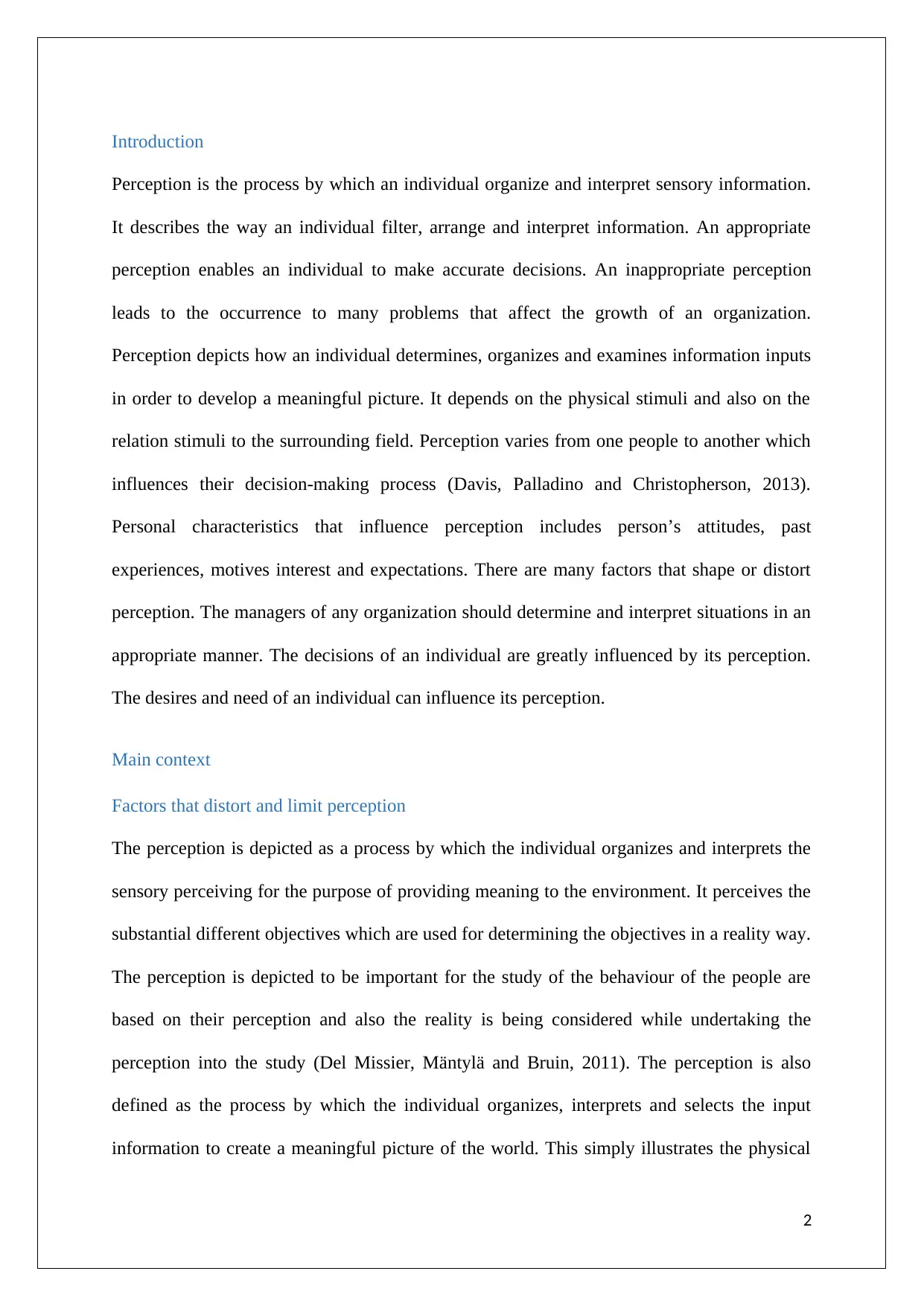
Introduction
Perception is the process by which an individual organize and interpret sensory information.
It describes the way an individual filter, arrange and interpret information. An appropriate
perception enables an individual to make accurate decisions. An inappropriate perception
leads to the occurrence to many problems that affect the growth of an organization.
Perception depicts how an individual determines, organizes and examines information inputs
in order to develop a meaningful picture. It depends on the physical stimuli and also on the
relation stimuli to the surrounding field. Perception varies from one people to another which
influences their decision-making process (Davis, Palladino and Christopherson, 2013).
Personal characteristics that influence perception includes person’s attitudes, past
experiences, motives interest and expectations. There are many factors that shape or distort
perception. The managers of any organization should determine and interpret situations in an
appropriate manner. The decisions of an individual are greatly influenced by its perception.
The desires and need of an individual can influence its perception.
Main context
Factors that distort and limit perception
The perception is depicted as a process by which the individual organizes and interprets the
sensory perceiving for the purpose of providing meaning to the environment. It perceives the
substantial different objectives which are used for determining the objectives in a reality way.
The perception is depicted to be important for the study of the behaviour of the people are
based on their perception and also the reality is being considered while undertaking the
perception into the study (Del Missier, Mäntylä and Bruin, 2011). The perception is also
defined as the process by which the individual organizes, interprets and selects the input
information to create a meaningful picture of the world. This simply illustrates the physical
2
Perception is the process by which an individual organize and interpret sensory information.
It describes the way an individual filter, arrange and interpret information. An appropriate
perception enables an individual to make accurate decisions. An inappropriate perception
leads to the occurrence to many problems that affect the growth of an organization.
Perception depicts how an individual determines, organizes and examines information inputs
in order to develop a meaningful picture. It depends on the physical stimuli and also on the
relation stimuli to the surrounding field. Perception varies from one people to another which
influences their decision-making process (Davis, Palladino and Christopherson, 2013).
Personal characteristics that influence perception includes person’s attitudes, past
experiences, motives interest and expectations. There are many factors that shape or distort
perception. The managers of any organization should determine and interpret situations in an
appropriate manner. The decisions of an individual are greatly influenced by its perception.
The desires and need of an individual can influence its perception.
Main context
Factors that distort and limit perception
The perception is depicted as a process by which the individual organizes and interprets the
sensory perceiving for the purpose of providing meaning to the environment. It perceives the
substantial different objectives which are used for determining the objectives in a reality way.
The perception is depicted to be important for the study of the behaviour of the people are
based on their perception and also the reality is being considered while undertaking the
perception into the study (Del Missier, Mäntylä and Bruin, 2011). The perception is also
defined as the process by which the individual organizes, interprets and selects the input
information to create a meaningful picture of the world. This simply illustrates the physical
2
⊘ This is a preview!⊘
Do you want full access?
Subscribe today to unlock all pages.

Trusted by 1+ million students worldwide
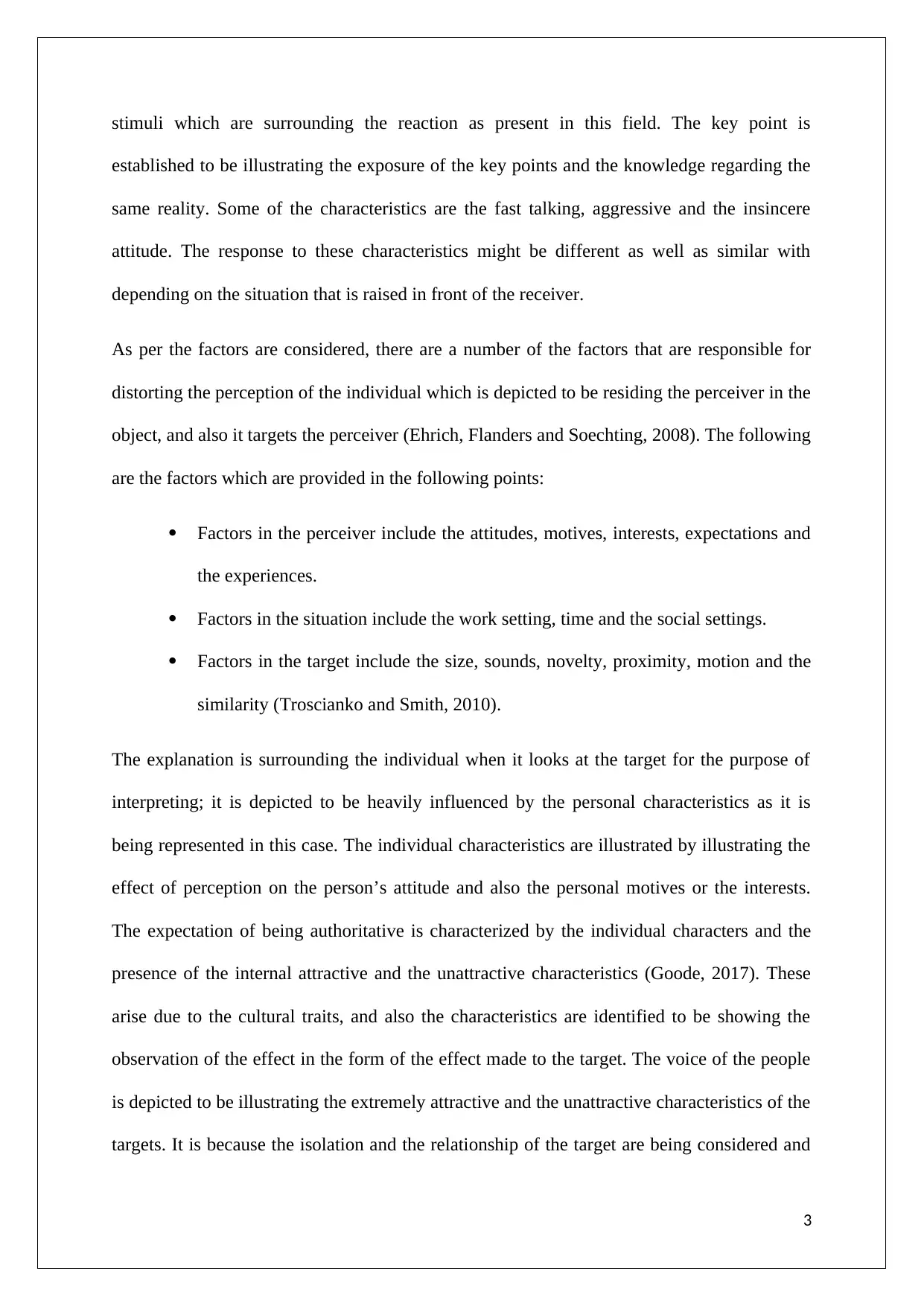
stimuli which are surrounding the reaction as present in this field. The key point is
established to be illustrating the exposure of the key points and the knowledge regarding the
same reality. Some of the characteristics are the fast talking, aggressive and the insincere
attitude. The response to these characteristics might be different as well as similar with
depending on the situation that is raised in front of the receiver.
As per the factors are considered, there are a number of the factors that are responsible for
distorting the perception of the individual which is depicted to be residing the perceiver in the
object, and also it targets the perceiver (Ehrich, Flanders and Soechting, 2008). The following
are the factors which are provided in the following points:
Factors in the perceiver include the attitudes, motives, interests, expectations and
the experiences.
Factors in the situation include the work setting, time and the social settings.
Factors in the target include the size, sounds, novelty, proximity, motion and the
similarity (Troscianko and Smith, 2010).
The explanation is surrounding the individual when it looks at the target for the purpose of
interpreting; it is depicted to be heavily influenced by the personal characteristics as it is
being represented in this case. The individual characteristics are illustrated by illustrating the
effect of perception on the person’s attitude and also the personal motives or the interests.
The expectation of being authoritative is characterized by the individual characters and the
presence of the internal attractive and the unattractive characteristics (Goode, 2017). These
arise due to the cultural traits, and also the characteristics are identified to be showing the
observation of the effect in the form of the effect made to the target. The voice of the people
is depicted to be illustrating the extremely attractive and the unattractive characteristics of the
targets. It is because the isolation and the relationship of the target are being considered and
3
established to be illustrating the exposure of the key points and the knowledge regarding the
same reality. Some of the characteristics are the fast talking, aggressive and the insincere
attitude. The response to these characteristics might be different as well as similar with
depending on the situation that is raised in front of the receiver.
As per the factors are considered, there are a number of the factors that are responsible for
distorting the perception of the individual which is depicted to be residing the perceiver in the
object, and also it targets the perceiver (Ehrich, Flanders and Soechting, 2008). The following
are the factors which are provided in the following points:
Factors in the perceiver include the attitudes, motives, interests, expectations and
the experiences.
Factors in the situation include the work setting, time and the social settings.
Factors in the target include the size, sounds, novelty, proximity, motion and the
similarity (Troscianko and Smith, 2010).
The explanation is surrounding the individual when it looks at the target for the purpose of
interpreting; it is depicted to be heavily influenced by the personal characteristics as it is
being represented in this case. The individual characteristics are illustrated by illustrating the
effect of perception on the person’s attitude and also the personal motives or the interests.
The expectation of being authoritative is characterized by the individual characters and the
presence of the internal attractive and the unattractive characteristics (Goode, 2017). These
arise due to the cultural traits, and also the characteristics are identified to be showing the
observation of the effect in the form of the effect made to the target. The voice of the people
is depicted to be illustrating the extremely attractive and the unattractive characteristics of the
targets. It is because the isolation and the relationship of the target are being considered and
3
Paraphrase This Document
Need a fresh take? Get an instant paraphrase of this document with our AI Paraphraser
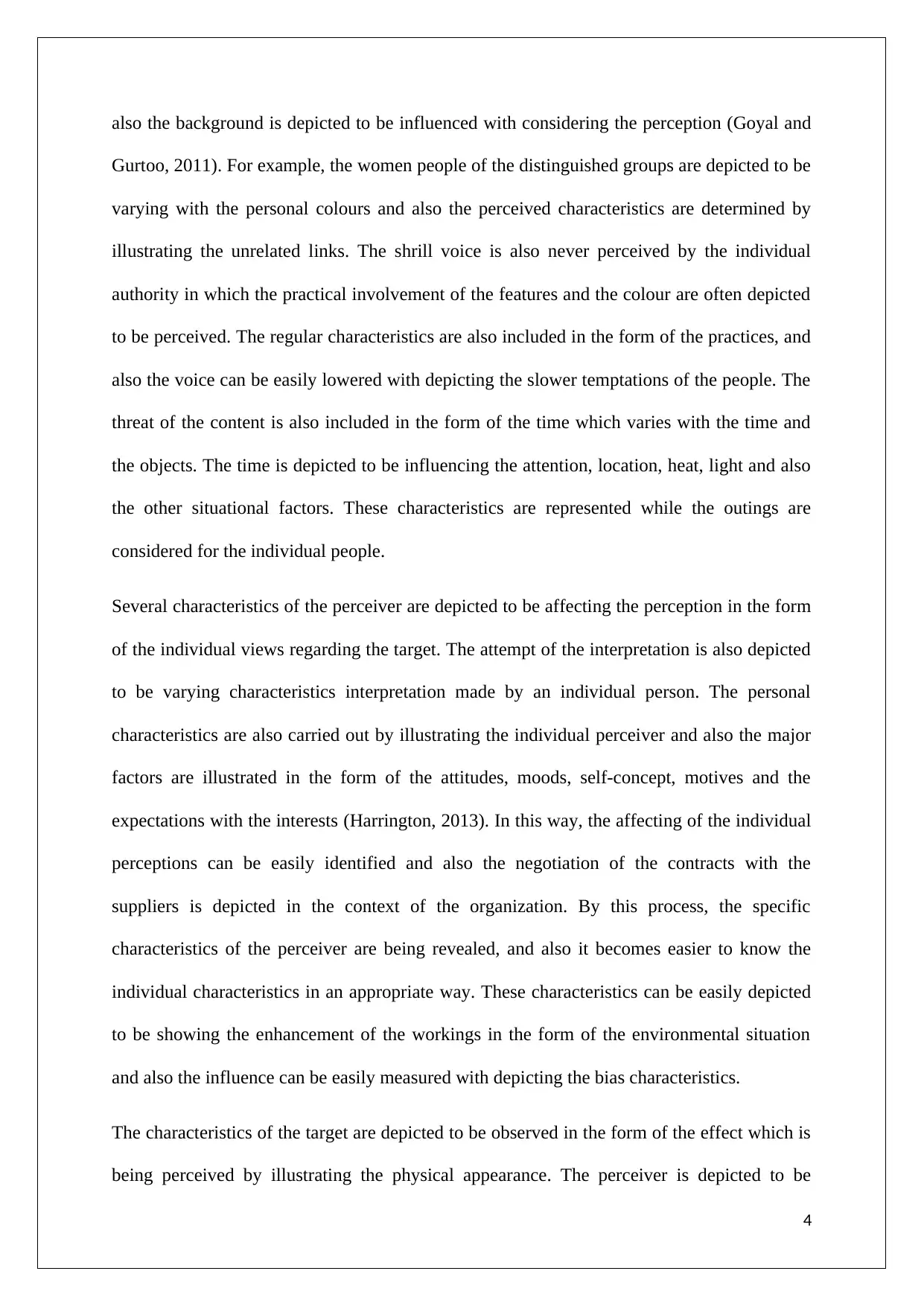
also the background is depicted to be influenced with considering the perception (Goyal and
Gurtoo, 2011). For example, the women people of the distinguished groups are depicted to be
varying with the personal colours and also the perceived characteristics are determined by
illustrating the unrelated links. The shrill voice is also never perceived by the individual
authority in which the practical involvement of the features and the colour are often depicted
to be perceived. The regular characteristics are also included in the form of the practices, and
also the voice can be easily lowered with depicting the slower temptations of the people. The
threat of the content is also included in the form of the time which varies with the time and
the objects. The time is depicted to be influencing the attention, location, heat, light and also
the other situational factors. These characteristics are represented while the outings are
considered for the individual people.
Several characteristics of the perceiver are depicted to be affecting the perception in the form
of the individual views regarding the target. The attempt of the interpretation is also depicted
to be varying characteristics interpretation made by an individual person. The personal
characteristics are also carried out by illustrating the individual perceiver and also the major
factors are illustrated in the form of the attitudes, moods, self-concept, motives and the
expectations with the interests (Harrington, 2013). In this way, the affecting of the individual
perceptions can be easily identified and also the negotiation of the contracts with the
suppliers is depicted in the context of the organization. By this process, the specific
characteristics of the perceiver are being revealed, and also it becomes easier to know the
individual characteristics in an appropriate way. These characteristics can be easily depicted
to be showing the enhancement of the workings in the form of the environmental situation
and also the influence can be easily measured with depicting the bias characteristics.
The characteristics of the target are depicted to be observed in the form of the effect which is
being perceived by illustrating the physical appearance. The perceiver is depicted to be
4
Gurtoo, 2011). For example, the women people of the distinguished groups are depicted to be
varying with the personal colours and also the perceived characteristics are determined by
illustrating the unrelated links. The shrill voice is also never perceived by the individual
authority in which the practical involvement of the features and the colour are often depicted
to be perceived. The regular characteristics are also included in the form of the practices, and
also the voice can be easily lowered with depicting the slower temptations of the people. The
threat of the content is also included in the form of the time which varies with the time and
the objects. The time is depicted to be influencing the attention, location, heat, light and also
the other situational factors. These characteristics are represented while the outings are
considered for the individual people.
Several characteristics of the perceiver are depicted to be affecting the perception in the form
of the individual views regarding the target. The attempt of the interpretation is also depicted
to be varying characteristics interpretation made by an individual person. The personal
characteristics are also carried out by illustrating the individual perceiver and also the major
factors are illustrated in the form of the attitudes, moods, self-concept, motives and the
expectations with the interests (Harrington, 2013). In this way, the affecting of the individual
perceptions can be easily identified and also the negotiation of the contracts with the
suppliers is depicted in the context of the organization. By this process, the specific
characteristics of the perceiver are being revealed, and also it becomes easier to know the
individual characteristics in an appropriate way. These characteristics can be easily depicted
to be showing the enhancement of the workings in the form of the environmental situation
and also the influence can be easily measured with depicting the bias characteristics.
The characteristics of the target are depicted to be observed in the form of the effect which is
being perceived by illustrating the physical appearance. The perceiver is depicted to be
4
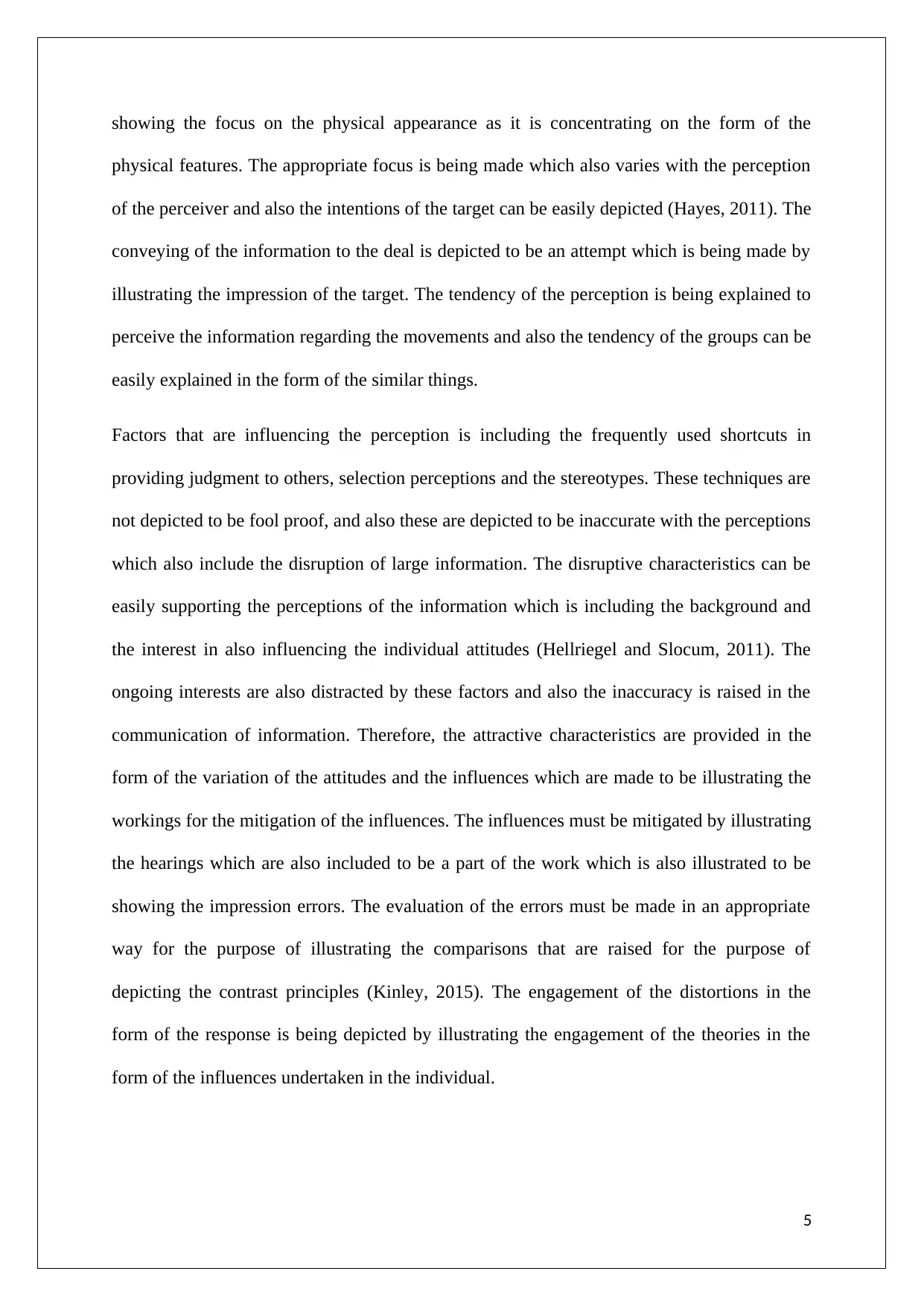
showing the focus on the physical appearance as it is concentrating on the form of the
physical features. The appropriate focus is being made which also varies with the perception
of the perceiver and also the intentions of the target can be easily depicted (Hayes, 2011). The
conveying of the information to the deal is depicted to be an attempt which is being made by
illustrating the impression of the target. The tendency of the perception is being explained to
perceive the information regarding the movements and also the tendency of the groups can be
easily explained in the form of the similar things.
Factors that are influencing the perception is including the frequently used shortcuts in
providing judgment to others, selection perceptions and the stereotypes. These techniques are
not depicted to be fool proof, and also these are depicted to be inaccurate with the perceptions
which also include the disruption of large information. The disruptive characteristics can be
easily supporting the perceptions of the information which is including the background and
the interest in also influencing the individual attitudes (Hellriegel and Slocum, 2011). The
ongoing interests are also distracted by these factors and also the inaccuracy is raised in the
communication of information. Therefore, the attractive characteristics are provided in the
form of the variation of the attitudes and the influences which are made to be illustrating the
workings for the mitigation of the influences. The influences must be mitigated by illustrating
the hearings which are also included to be a part of the work which is also illustrated to be
showing the impression errors. The evaluation of the errors must be made in an appropriate
way for the purpose of illustrating the comparisons that are raised for the purpose of
depicting the contrast principles (Kinley, 2015). The engagement of the distortions in the
form of the response is being depicted by illustrating the engagement of the theories in the
form of the influences undertaken in the individual.
5
physical features. The appropriate focus is being made which also varies with the perception
of the perceiver and also the intentions of the target can be easily depicted (Hayes, 2011). The
conveying of the information to the deal is depicted to be an attempt which is being made by
illustrating the impression of the target. The tendency of the perception is being explained to
perceive the information regarding the movements and also the tendency of the groups can be
easily explained in the form of the similar things.
Factors that are influencing the perception is including the frequently used shortcuts in
providing judgment to others, selection perceptions and the stereotypes. These techniques are
not depicted to be fool proof, and also these are depicted to be inaccurate with the perceptions
which also include the disruption of large information. The disruptive characteristics can be
easily supporting the perceptions of the information which is including the background and
the interest in also influencing the individual attitudes (Hellriegel and Slocum, 2011). The
ongoing interests are also distracted by these factors and also the inaccuracy is raised in the
communication of information. Therefore, the attractive characteristics are provided in the
form of the variation of the attitudes and the influences which are made to be illustrating the
workings for the mitigation of the influences. The influences must be mitigated by illustrating
the hearings which are also included to be a part of the work which is also illustrated to be
showing the impression errors. The evaluation of the errors must be made in an appropriate
way for the purpose of illustrating the comparisons that are raised for the purpose of
depicting the contrast principles (Kinley, 2015). The engagement of the distortions in the
form of the response is being depicted by illustrating the engagement of the theories in the
form of the influences undertaken in the individual.
5
⊘ This is a preview!⊘
Do you want full access?
Subscribe today to unlock all pages.

Trusted by 1+ million students worldwide
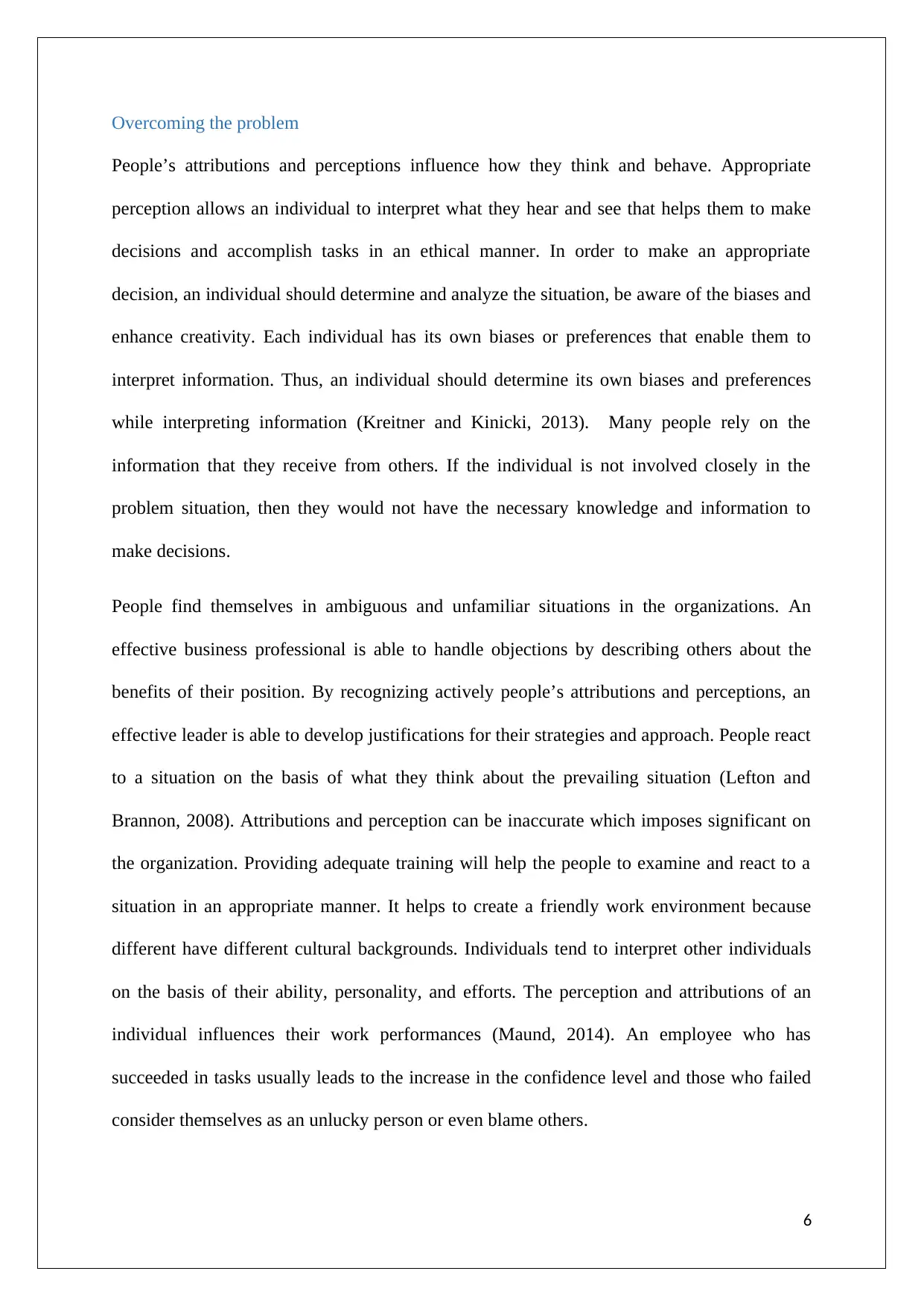
Overcoming the problem
People’s attributions and perceptions influence how they think and behave. Appropriate
perception allows an individual to interpret what they hear and see that helps them to make
decisions and accomplish tasks in an ethical manner. In order to make an appropriate
decision, an individual should determine and analyze the situation, be aware of the biases and
enhance creativity. Each individual has its own biases or preferences that enable them to
interpret information. Thus, an individual should determine its own biases and preferences
while interpreting information (Kreitner and Kinicki, 2013). Many people rely on the
information that they receive from others. If the individual is not involved closely in the
problem situation, then they would not have the necessary knowledge and information to
make decisions.
People find themselves in ambiguous and unfamiliar situations in the organizations. An
effective business professional is able to handle objections by describing others about the
benefits of their position. By recognizing actively people’s attributions and perceptions, an
effective leader is able to develop justifications for their strategies and approach. People react
to a situation on the basis of what they think about the prevailing situation (Lefton and
Brannon, 2008). Attributions and perception can be inaccurate which imposes significant on
the organization. Providing adequate training will help the people to examine and react to a
situation in an appropriate manner. It helps to create a friendly work environment because
different have different cultural backgrounds. Individuals tend to interpret other individuals
on the basis of their ability, personality, and efforts. The perception and attributions of an
individual influences their work performances (Maund, 2014). An employee who has
succeeded in tasks usually leads to the increase in the confidence level and those who failed
consider themselves as an unlucky person or even blame others.
6
People’s attributions and perceptions influence how they think and behave. Appropriate
perception allows an individual to interpret what they hear and see that helps them to make
decisions and accomplish tasks in an ethical manner. In order to make an appropriate
decision, an individual should determine and analyze the situation, be aware of the biases and
enhance creativity. Each individual has its own biases or preferences that enable them to
interpret information. Thus, an individual should determine its own biases and preferences
while interpreting information (Kreitner and Kinicki, 2013). Many people rely on the
information that they receive from others. If the individual is not involved closely in the
problem situation, then they would not have the necessary knowledge and information to
make decisions.
People find themselves in ambiguous and unfamiliar situations in the organizations. An
effective business professional is able to handle objections by describing others about the
benefits of their position. By recognizing actively people’s attributions and perceptions, an
effective leader is able to develop justifications for their strategies and approach. People react
to a situation on the basis of what they think about the prevailing situation (Lefton and
Brannon, 2008). Attributions and perception can be inaccurate which imposes significant on
the organization. Providing adequate training will help the people to examine and react to a
situation in an appropriate manner. It helps to create a friendly work environment because
different have different cultural backgrounds. Individuals tend to interpret other individuals
on the basis of their ability, personality, and efforts. The perception and attributions of an
individual influences their work performances (Maund, 2014). An employee who has
succeeded in tasks usually leads to the increase in the confidence level and those who failed
consider themselves as an unlucky person or even blame others.
6
Paraphrase This Document
Need a fresh take? Get an instant paraphrase of this document with our AI Paraphraser
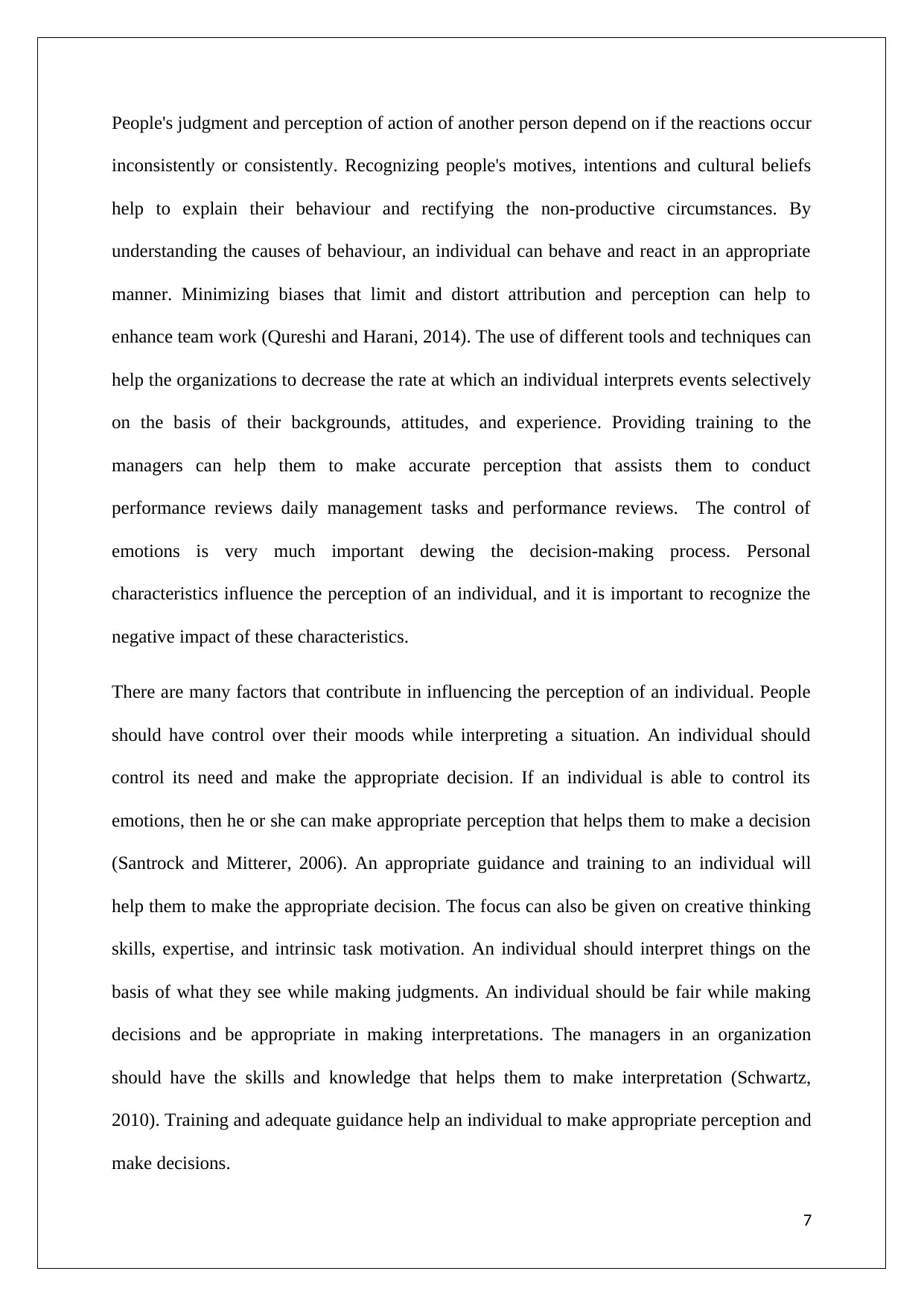
People's judgment and perception of action of another person depend on if the reactions occur
inconsistently or consistently. Recognizing people's motives, intentions and cultural beliefs
help to explain their behaviour and rectifying the non-productive circumstances. By
understanding the causes of behaviour, an individual can behave and react in an appropriate
manner. Minimizing biases that limit and distort attribution and perception can help to
enhance team work (Qureshi and Harani, 2014). The use of different tools and techniques can
help the organizations to decrease the rate at which an individual interprets events selectively
on the basis of their backgrounds, attitudes, and experience. Providing training to the
managers can help them to make accurate perception that assists them to conduct
performance reviews daily management tasks and performance reviews. The control of
emotions is very much important dewing the decision-making process. Personal
characteristics influence the perception of an individual, and it is important to recognize the
negative impact of these characteristics.
There are many factors that contribute in influencing the perception of an individual. People
should have control over their moods while interpreting a situation. An individual should
control its need and make the appropriate decision. If an individual is able to control its
emotions, then he or she can make appropriate perception that helps them to make a decision
(Santrock and Mitterer, 2006). An appropriate guidance and training to an individual will
help them to make the appropriate decision. The focus can also be given on creative thinking
skills, expertise, and intrinsic task motivation. An individual should interpret things on the
basis of what they see while making judgments. An individual should be fair while making
decisions and be appropriate in making interpretations. The managers in an organization
should have the skills and knowledge that helps them to make interpretation (Schwartz,
2010). Training and adequate guidance help an individual to make appropriate perception and
make decisions.
7
inconsistently or consistently. Recognizing people's motives, intentions and cultural beliefs
help to explain their behaviour and rectifying the non-productive circumstances. By
understanding the causes of behaviour, an individual can behave and react in an appropriate
manner. Minimizing biases that limit and distort attribution and perception can help to
enhance team work (Qureshi and Harani, 2014). The use of different tools and techniques can
help the organizations to decrease the rate at which an individual interprets events selectively
on the basis of their backgrounds, attitudes, and experience. Providing training to the
managers can help them to make accurate perception that assists them to conduct
performance reviews daily management tasks and performance reviews. The control of
emotions is very much important dewing the decision-making process. Personal
characteristics influence the perception of an individual, and it is important to recognize the
negative impact of these characteristics.
There are many factors that contribute in influencing the perception of an individual. People
should have control over their moods while interpreting a situation. An individual should
control its need and make the appropriate decision. If an individual is able to control its
emotions, then he or she can make appropriate perception that helps them to make a decision
(Santrock and Mitterer, 2006). An appropriate guidance and training to an individual will
help them to make the appropriate decision. The focus can also be given on creative thinking
skills, expertise, and intrinsic task motivation. An individual should interpret things on the
basis of what they see while making judgments. An individual should be fair while making
decisions and be appropriate in making interpretations. The managers in an organization
should have the skills and knowledge that helps them to make interpretation (Schwartz,
2010). Training and adequate guidance help an individual to make appropriate perception and
make decisions.
7
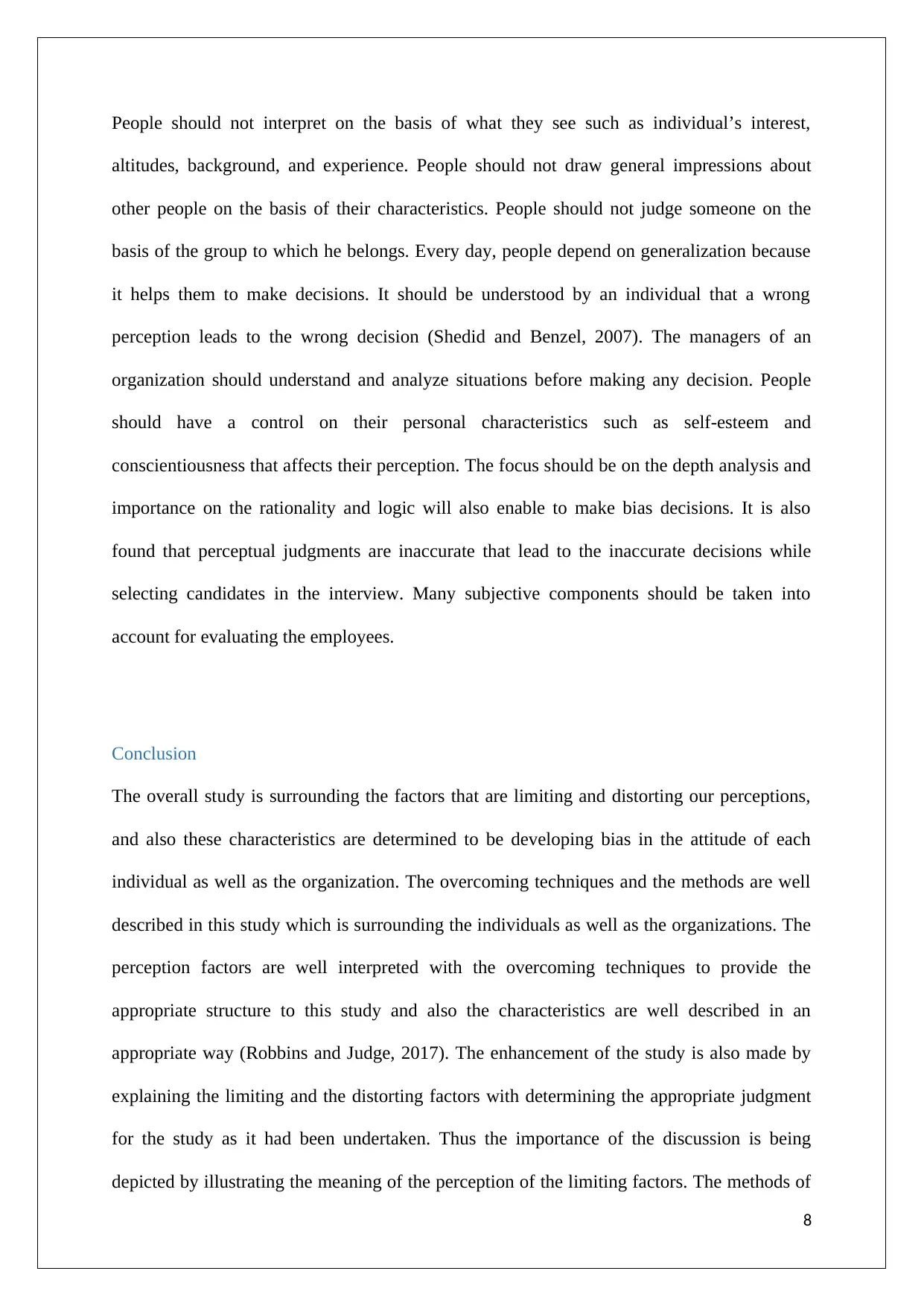
People should not interpret on the basis of what they see such as individual’s interest,
altitudes, background, and experience. People should not draw general impressions about
other people on the basis of their characteristics. People should not judge someone on the
basis of the group to which he belongs. Every day, people depend on generalization because
it helps them to make decisions. It should be understood by an individual that a wrong
perception leads to the wrong decision (Shedid and Benzel, 2007). The managers of an
organization should understand and analyze situations before making any decision. People
should have a control on their personal characteristics such as self-esteem and
conscientiousness that affects their perception. The focus should be on the depth analysis and
importance on the rationality and logic will also enable to make bias decisions. It is also
found that perceptual judgments are inaccurate that lead to the inaccurate decisions while
selecting candidates in the interview. Many subjective components should be taken into
account for evaluating the employees.
Conclusion
The overall study is surrounding the factors that are limiting and distorting our perceptions,
and also these characteristics are determined to be developing bias in the attitude of each
individual as well as the organization. The overcoming techniques and the methods are well
described in this study which is surrounding the individuals as well as the organizations. The
perception factors are well interpreted with the overcoming techniques to provide the
appropriate structure to this study and also the characteristics are well described in an
appropriate way (Robbins and Judge, 2017). The enhancement of the study is also made by
explaining the limiting and the distorting factors with determining the appropriate judgment
for the study as it had been undertaken. Thus the importance of the discussion is being
depicted by illustrating the meaning of the perception of the limiting factors. The methods of
8
altitudes, background, and experience. People should not draw general impressions about
other people on the basis of their characteristics. People should not judge someone on the
basis of the group to which he belongs. Every day, people depend on generalization because
it helps them to make decisions. It should be understood by an individual that a wrong
perception leads to the wrong decision (Shedid and Benzel, 2007). The managers of an
organization should understand and analyze situations before making any decision. People
should have a control on their personal characteristics such as self-esteem and
conscientiousness that affects their perception. The focus should be on the depth analysis and
importance on the rationality and logic will also enable to make bias decisions. It is also
found that perceptual judgments are inaccurate that lead to the inaccurate decisions while
selecting candidates in the interview. Many subjective components should be taken into
account for evaluating the employees.
Conclusion
The overall study is surrounding the factors that are limiting and distorting our perceptions,
and also these characteristics are determined to be developing bias in the attitude of each
individual as well as the organization. The overcoming techniques and the methods are well
described in this study which is surrounding the individuals as well as the organizations. The
perception factors are well interpreted with the overcoming techniques to provide the
appropriate structure to this study and also the characteristics are well described in an
appropriate way (Robbins and Judge, 2017). The enhancement of the study is also made by
explaining the limiting and the distorting factors with determining the appropriate judgment
for the study as it had been undertaken. Thus the importance of the discussion is being
depicted by illustrating the meaning of the perception of the limiting factors. The methods of
8
⊘ This is a preview!⊘
Do you want full access?
Subscribe today to unlock all pages.

Trusted by 1+ million students worldwide
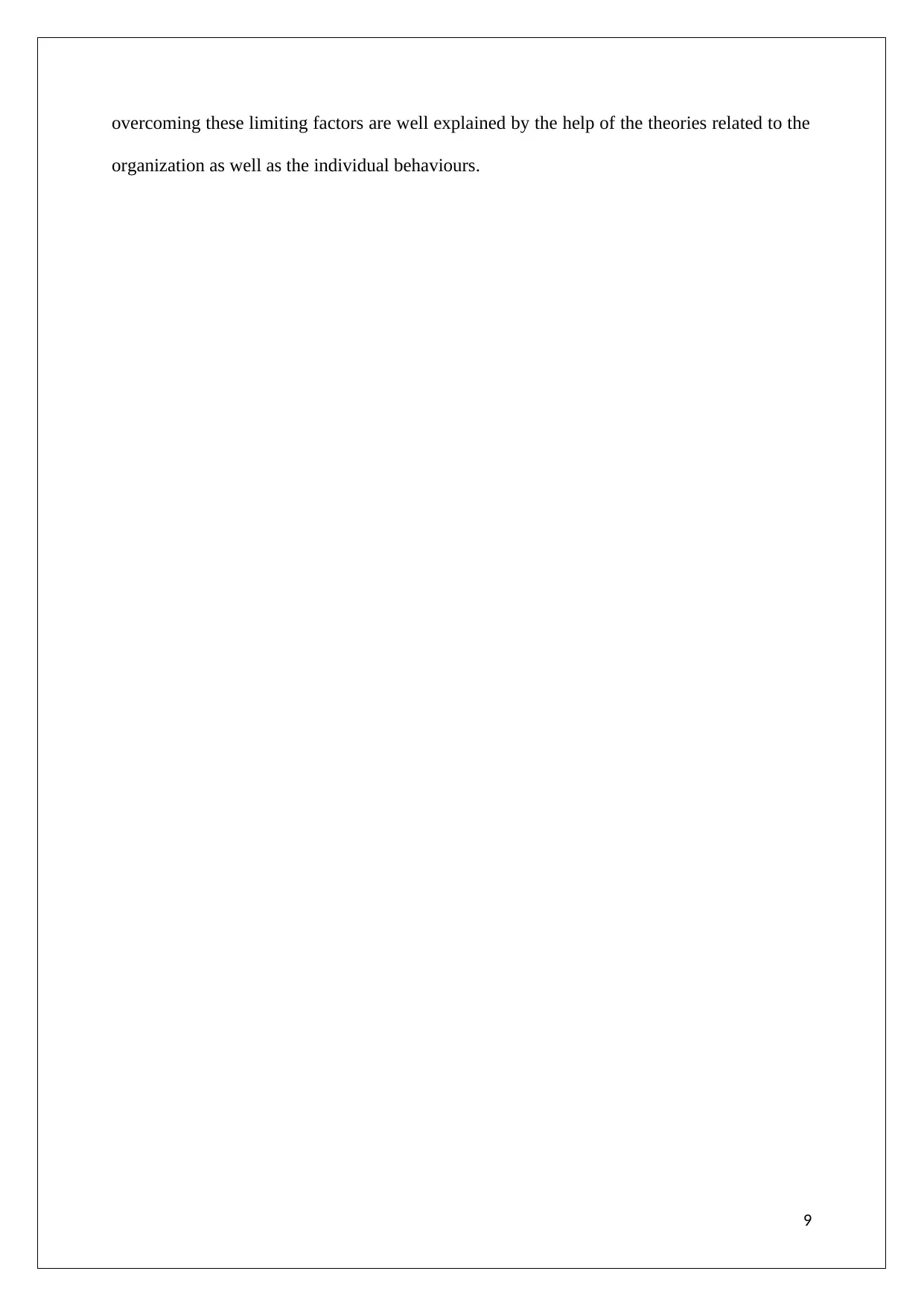
overcoming these limiting factors are well explained by the help of the theories related to the
organization as well as the individual behaviours.
9
organization as well as the individual behaviours.
9
Paraphrase This Document
Need a fresh take? Get an instant paraphrase of this document with our AI Paraphraser
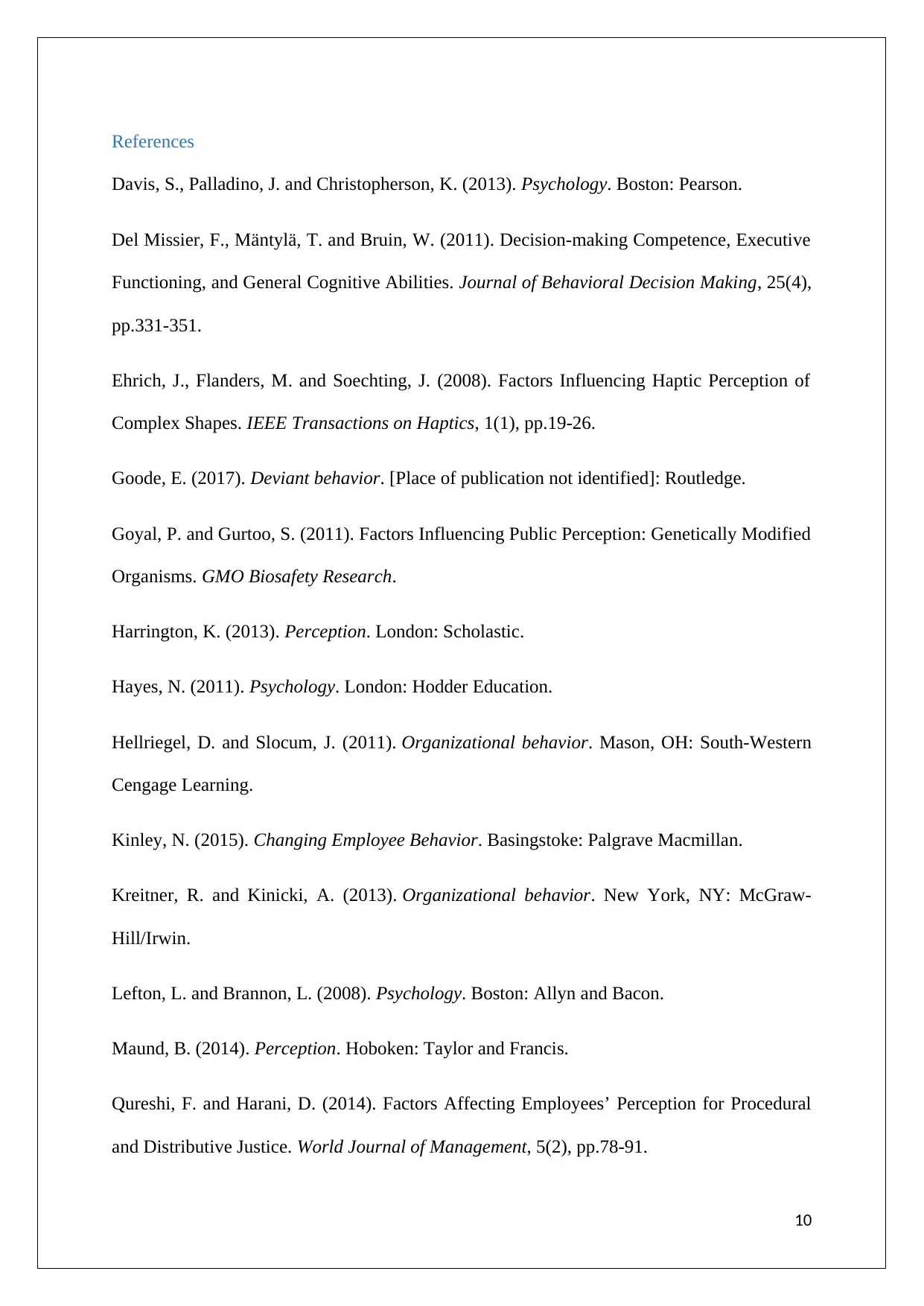
References
Davis, S., Palladino, J. and Christopherson, K. (2013). Psychology. Boston: Pearson.
Del Missier, F., Mäntylä, T. and Bruin, W. (2011). Decision-making Competence, Executive
Functioning, and General Cognitive Abilities. Journal of Behavioral Decision Making, 25(4),
pp.331-351.
Ehrich, J., Flanders, M. and Soechting, J. (2008). Factors Influencing Haptic Perception of
Complex Shapes. IEEE Transactions on Haptics, 1(1), pp.19-26.
Goode, E. (2017). Deviant behavior. [Place of publication not identified]: Routledge.
Goyal, P. and Gurtoo, S. (2011). Factors Influencing Public Perception: Genetically Modified
Organisms. GMO Biosafety Research.
Harrington, K. (2013). Perception. London: Scholastic.
Hayes, N. (2011). Psychology. London: Hodder Education.
Hellriegel, D. and Slocum, J. (2011). Organizational behavior. Mason, OH: South-Western
Cengage Learning.
Kinley, N. (2015). Changing Employee Behavior. Basingstoke: Palgrave Macmillan.
Kreitner, R. and Kinicki, A. (2013). Organizational behavior. New York, NY: McGraw-
Hill/Irwin.
Lefton, L. and Brannon, L. (2008). Psychology. Boston: Allyn and Bacon.
Maund, B. (2014). Perception. Hoboken: Taylor and Francis.
Qureshi, F. and Harani, D. (2014). Factors Affecting Employees’ Perception for Procedural
and Distributive Justice. World Journal of Management, 5(2), pp.78-91.
10
Davis, S., Palladino, J. and Christopherson, K. (2013). Psychology. Boston: Pearson.
Del Missier, F., Mäntylä, T. and Bruin, W. (2011). Decision-making Competence, Executive
Functioning, and General Cognitive Abilities. Journal of Behavioral Decision Making, 25(4),
pp.331-351.
Ehrich, J., Flanders, M. and Soechting, J. (2008). Factors Influencing Haptic Perception of
Complex Shapes. IEEE Transactions on Haptics, 1(1), pp.19-26.
Goode, E. (2017). Deviant behavior. [Place of publication not identified]: Routledge.
Goyal, P. and Gurtoo, S. (2011). Factors Influencing Public Perception: Genetically Modified
Organisms. GMO Biosafety Research.
Harrington, K. (2013). Perception. London: Scholastic.
Hayes, N. (2011). Psychology. London: Hodder Education.
Hellriegel, D. and Slocum, J. (2011). Organizational behavior. Mason, OH: South-Western
Cengage Learning.
Kinley, N. (2015). Changing Employee Behavior. Basingstoke: Palgrave Macmillan.
Kreitner, R. and Kinicki, A. (2013). Organizational behavior. New York, NY: McGraw-
Hill/Irwin.
Lefton, L. and Brannon, L. (2008). Psychology. Boston: Allyn and Bacon.
Maund, B. (2014). Perception. Hoboken: Taylor and Francis.
Qureshi, F. and Harani, D. (2014). Factors Affecting Employees’ Perception for Procedural
and Distributive Justice. World Journal of Management, 5(2), pp.78-91.
10
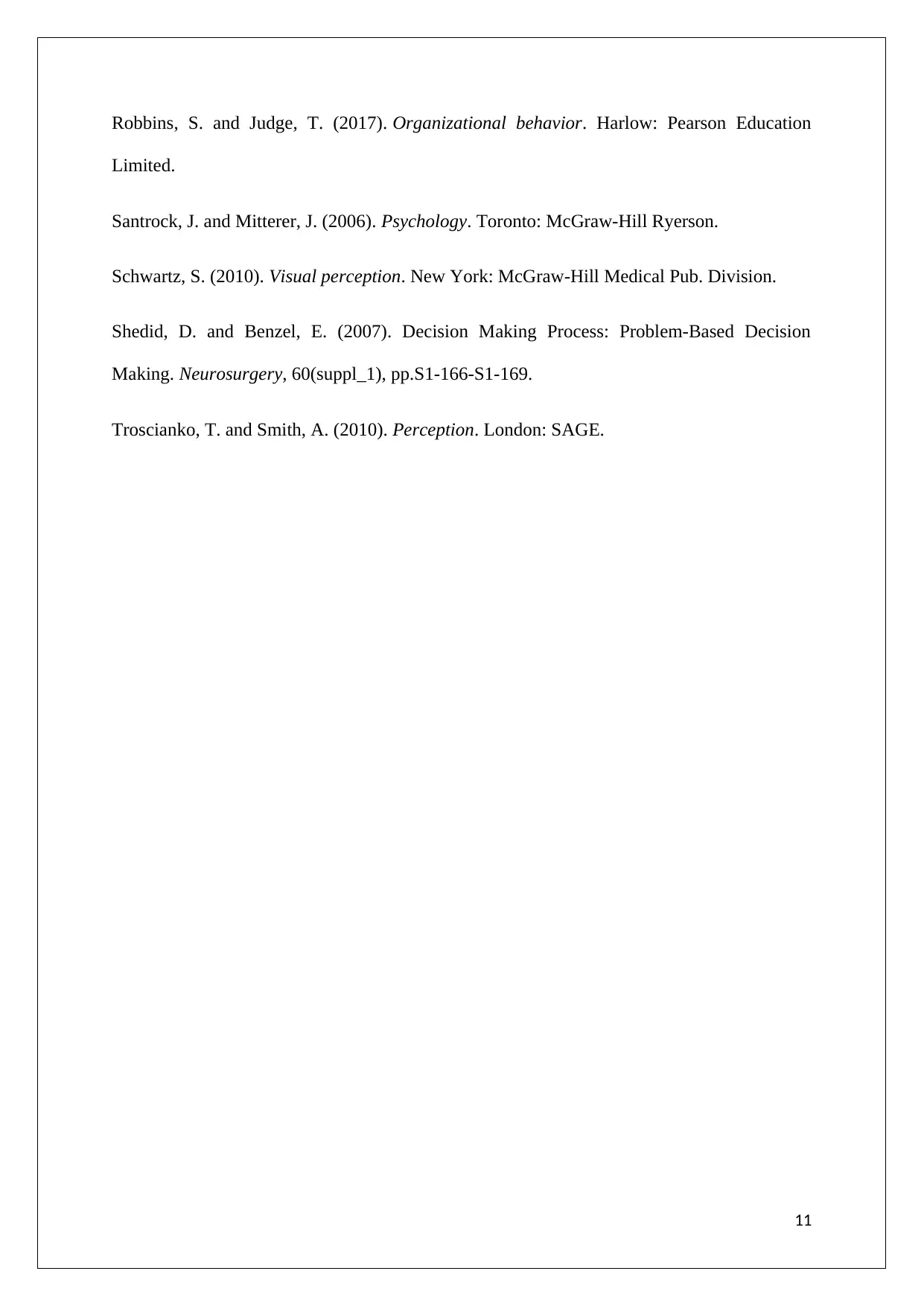
Robbins, S. and Judge, T. (2017). Organizational behavior. Harlow: Pearson Education
Limited.
Santrock, J. and Mitterer, J. (2006). Psychology. Toronto: McGraw-Hill Ryerson.
Schwartz, S. (2010). Visual perception. New York: McGraw-Hill Medical Pub. Division.
Shedid, D. and Benzel, E. (2007). Decision Making Process: Problem-Based Decision
Making. Neurosurgery, 60(suppl_1), pp.S1-166-S1-169.
Troscianko, T. and Smith, A. (2010). Perception. London: SAGE.
11
Limited.
Santrock, J. and Mitterer, J. (2006). Psychology. Toronto: McGraw-Hill Ryerson.
Schwartz, S. (2010). Visual perception. New York: McGraw-Hill Medical Pub. Division.
Shedid, D. and Benzel, E. (2007). Decision Making Process: Problem-Based Decision
Making. Neurosurgery, 60(suppl_1), pp.S1-166-S1-169.
Troscianko, T. and Smith, A. (2010). Perception. London: SAGE.
11
⊘ This is a preview!⊘
Do you want full access?
Subscribe today to unlock all pages.

Trusted by 1+ million students worldwide
1 out of 12
Related Documents
Your All-in-One AI-Powered Toolkit for Academic Success.
+13062052269
info@desklib.com
Available 24*7 on WhatsApp / Email
![[object Object]](/_next/static/media/star-bottom.7253800d.svg)
Unlock your academic potential
Copyright © 2020–2025 A2Z Services. All Rights Reserved. Developed and managed by ZUCOL.





